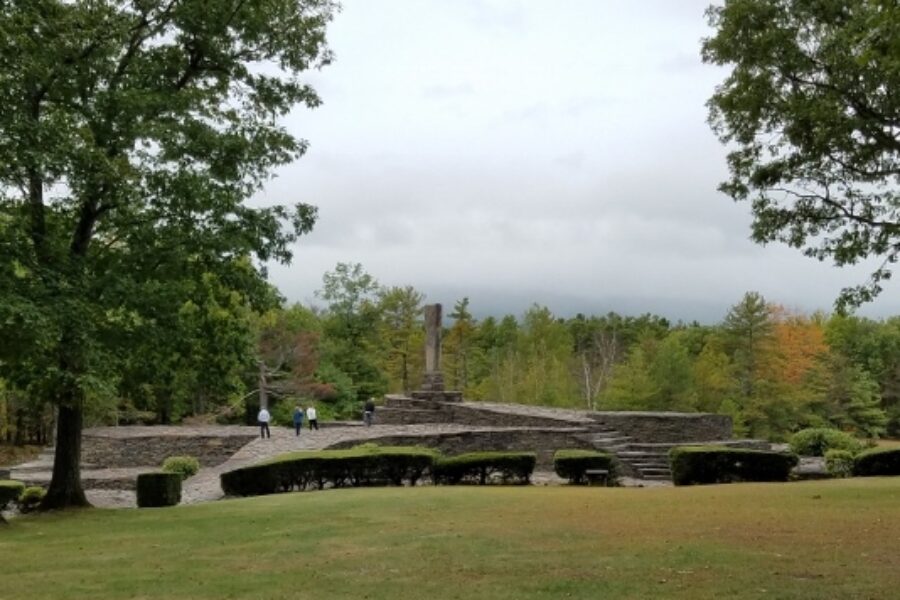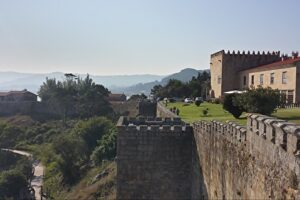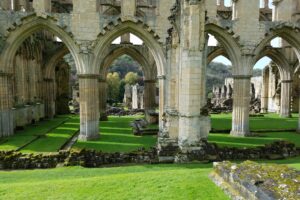On our way home, just outside of Saugerties and close to Woodstock, we take a detour. The sign says Opus 40. I know it is a sculpture garden—part of a defunct bluestone quarry. I put it on my list to see during the infancy of my planning this trip, but once here, there was so much to see and so much to do; it was overwhelming. Opus 40 was almost forgotten.
Leaving the car behind, I see Opus 40 from afar and think, OK, this is interesting, and I presume that what I see is it. There is nothing more. But then I watch a video of its history and proceed to walk on it and in it and through it, and I gasp for breath. One man built this. ONE MAN! On his own—ONE MAN working on it for thirty-seven years. Opus 40 is a symphony in dry-stacked stone, sculpted into terraces, alleys, ramps, steps, and rain-fed pools. It is never-ending.
The man who created this has a name, Harvey Fite. He perished in an accident three years before he estimated his Opus would be complete.
This may be the most magical thing I have ever seen. It is modern and ancient and simple and complex and jagged and smooth. Opus 40 is Stonehenge and Chaco Canyon and the broken streets of old cities and the exquisite MOMA in Fort Worth. It is every city’s MOMA and every church’s altar. I expect to hear the haunting melody of flutes from the Andes or primordial chants or the cries of sacrifice. Oh my gosh, I can’t believe it—ONE MAN! Imagining, lifting, placing, sculpting—one man.










Pictures do not tell the tale. You have to be here. I’m glad I am.
I wander at will, leaving Michael to his own devices, following a trail in the woods that curls and turns and leads me through a muddy track and back to the stacked stone wall that I circle and climb—again.










Harvey Fite
Harvey Fite was a renaissance man. He was a sculptor, painter, earth artist, teacher, and innovator. Fite studied law, the ministry and tried his hand at acting. By pure chance, he discovered his true passion for the arts and sculpting during his time with a theater troupe in Woodstock.
Becoming a recognized sculptor, in 1933, at the age of 36, Fite was invited to create a fine arts program at Bard College. Five years after organizing this department, Harvey Fite purchased a defunct bluestone quarry, planning on making the area his home, with room for a sculpture garden and a hand-built wooden house.
During that same year, he was invited by the Carnegie Institute to do restoration work on ancient Mayan sculptures in Copan, Honduras. It turned out to be a serendipitous invitation because the Maya’s art and architecture, especially their method of dry-stone construction, had a profound influence on him. So profound that the following spring, in addition to building his home, he began to organize the rubble scattered about the disused quarry, starting what eventually became his life’s work.
Harvey Fite named his masterwork Opus 40 because, in the beginning, he determined it would take him 40 years to complete his dream. Seven years after he retired from teaching, and thirty-seven years after the inception of Opus 40, while working on an open-air theater portion of the project, he fell to his death from a 12-foot precipice. He was 72 years old.
Opus 40 is Harvey Fite’s Unfinished Symphony, his wife insisting that his work remain where he left off, as a lasting tribute to his memory and achievements.









Leave a Reply
Your email is safe with us.